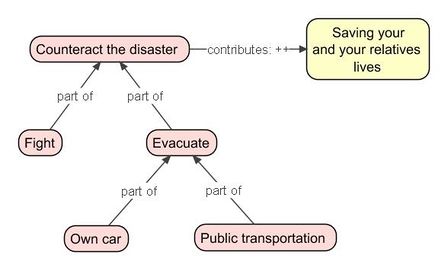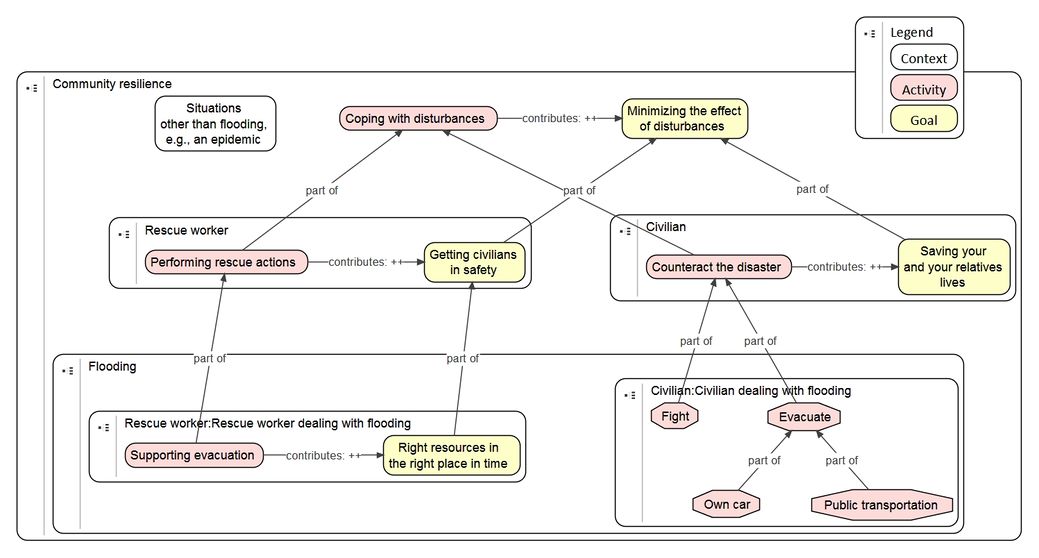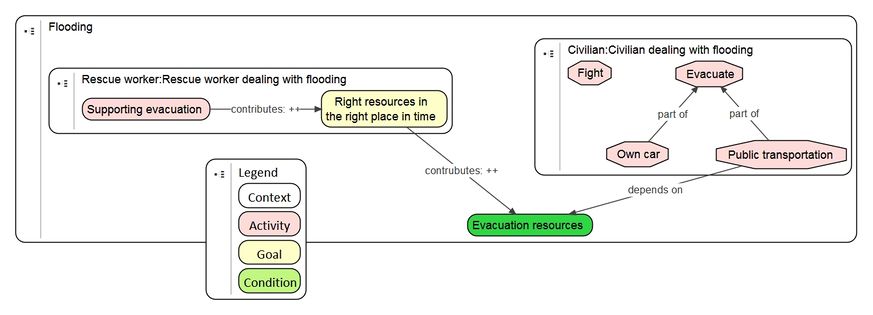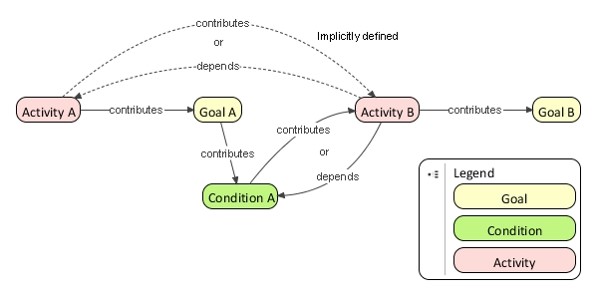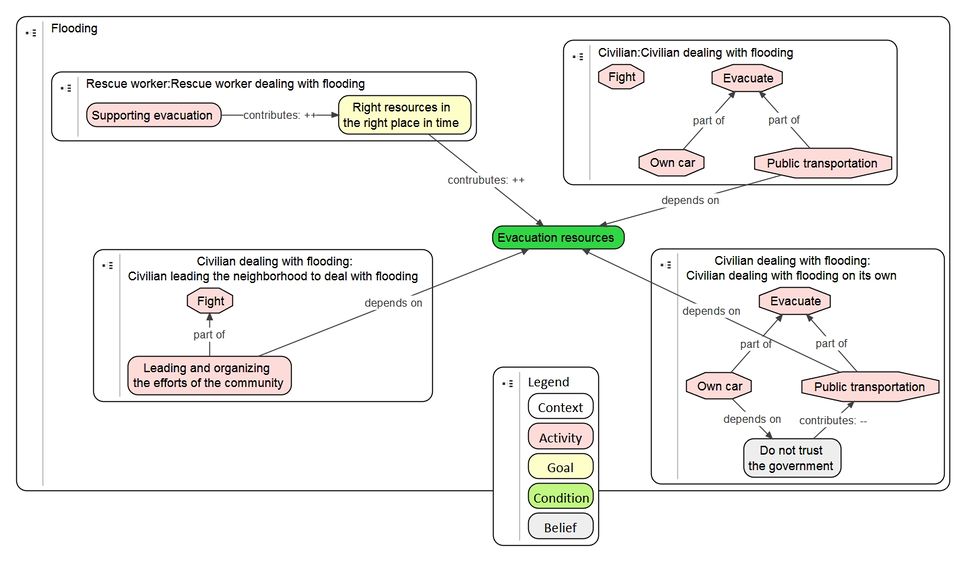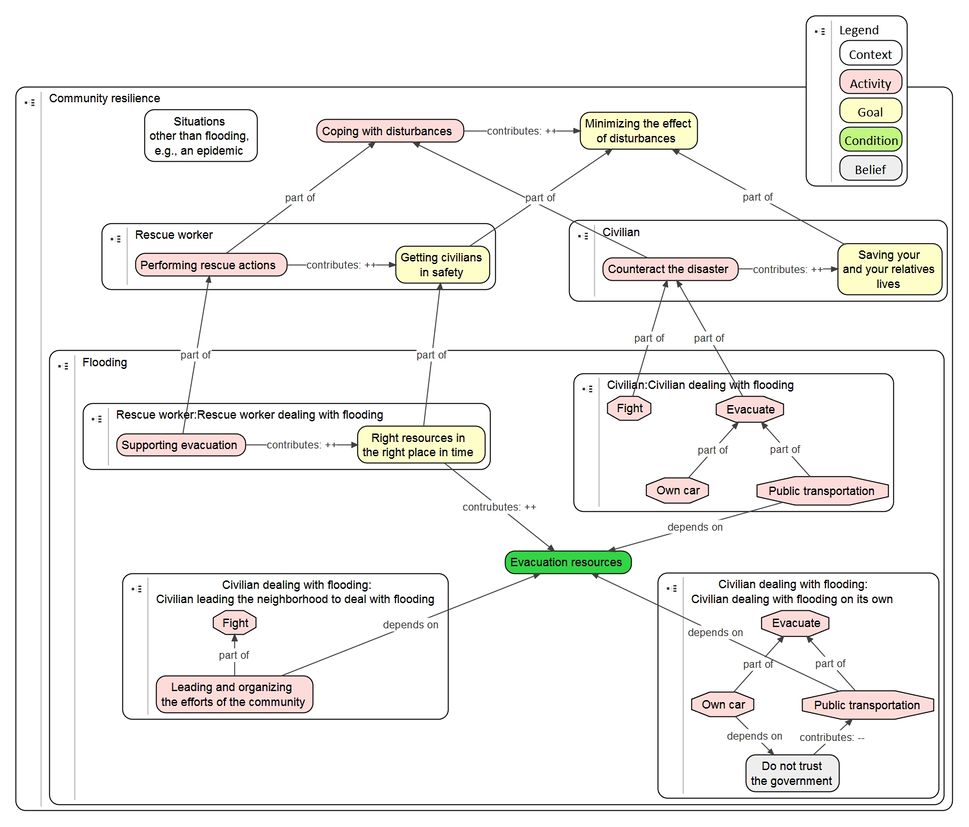Introducing EMont with help of a case
EMont describes and assesses knowing-how knowledge (expertise, behavior and (non-)human activities) and worldviews. The ontology consists of seven modeling elements, which will be introduced shortly with help of the fictitious and simplified situation of people counteracting a flooding disaster.
Capturing activities with the PQR formula
In EMM human behavior is defined as 'human activity systems’. Human activity systems, as well as activities of other kinds of actors (e.g. machinery), can be modeled with help of the PQR formula. This formula originates from the Soft Systems Methodology, and has to be applied as a root definition: a statement written in a few sentences capturing the intention of someone’s worldview. It concisely captures (human) activities executed to deal with particular circumstances which are motivated by the actors' worldview. The PQR formula is pivotal to EMont. The letters P, Q and R do not resemble anything, except for being subsequent letters in the alphabet. A specific meaning, however, is attached to these letters:
| PQR | Meaning | ||
|---|---|---|---|
| P | What? | Activity | What activity are we going to do, perform, execute or what process is going to happen? |
| Q | How? | Sub-activity | In what way are we going to do it? |
| R | Why? | Goal | What goal do we want to achieve? |
Do P by a Q in order to achieve R.Applying the PQR formula touches upon the expertise or knowing-how knowledge of an expert, who, based on his experience, intuitively knows what to do in specific situations. In other words, an expert applies the right activity patterns almost without consciously thinking. The PQR formula in the case of counteracting a disaster (see figure 1) looks like:
You can counteract the disaster (P - what) by, depending on the circumstances, fighting it (Q1 - how) or evacuating (Q2 - how) in order to save your and your relatives' lives (R - why).
The PQR formula can be applied recursively. A How (Q) can be decomposed in more specific or diverse How's (Q's). To continue from the example in figure 1: the evacuation activity can be subdivided into evacuation by car (Q2,1) or by public transport (Q2,2). Hence, the evacuation activity (Q2) gets the status of an activity (P) for its constituents.
Generalizing from the example in figure 1: by applying the PQR formula recursively, we can model an experts’ knowledge, that is, his behavioral patterns, at any desired level of detail. The main activity (P) and main goal (R) address what should be done in a situation, they however do not yet specify how (Q) it can be done. Consequently, activities usually consist of more specific sub-activities (Q's), which altogether contribute to the main activity (P). Just like activities, goals can be decomposed into sub-goals as well.
Activities in contexts
A situation is a network of actors, whether human or not, brought together to accomplishing shared or non-shared goals. These situations can also be called 'nested cognitive patterns of human activity systems'. In the situation “Community resilience” (figure 2) a community tries to cope with disturbances (main activity - what) by minimizing the effect of disturbances (main goal - why), including the more specific and nested situation "Flooding". Technically, the situation is modeled as a context, usually built up from different sub-contexts. The sub-context always has at least one 'super context'. Subsequently, roles or responsibilities of actors in situations are modeled as (sub-)contexts as well. Specific roles apply to specific situations. For example, the role “Civilian:Civilian dealing with flooding” shows that the role “Civilian dealing with flooding” is a sub-context of the situation “Flooding” and at the same time it is a sub-context of the role “Civilian”. Thus, a sub-context can be derived from more than one super context.To conclude, it can be observed that a context is used to model situations comprising of sub-situations and roles. In turn, a role may be regarded as a situation for its constituents. That is, a role can be seen as a situation made up of sub-roles and sub-situations. Another typical example of a context presented as a role is an organization with its specific objective or responsibility where its employees are engaged in specific activities. From the perspective of an employee however, the organization may appear as a situation to operate in rather than a role. So it is a matter of perspective from which we can abstract away by using the general concept of nested contexts.
Interdependencies and relations between elements
A situation is characterized by the interactions between actors and one or more conditions. Conditions determine how and how well the actors in a situation interact and execute activities, but conditions can also be influenced by the behavior of actors. A condition is often defined in a qualified way, e.g. “the availability of rescue workers”, or “ sufficient supply of evacuation resources”. As a result, a condition can also be regarded as an internal system indicator.
Typically, a goal and condition are related, expressed by the relation “contributes to”: a goal contributes to a condition. In figure 3, the goal “Right resources in the right place in time” contributes positively to the condition “Evacuation resources”. In other words, the condition is an indication of the extent to which the goal has been achieved. Note, a goal and a condition are deliberately modeled as different elements, because in real situations it frequently occurs that achieving one goal (contributing to a condition) can be undermined by achieving another goal (contributing to the same condition), e.g. the goal of a local government to mainly invest in and distribute inflatable boats for evacuation.
The examples in figures 3 and 4 show the type and quality of relations between activities, goals and conditions.
- Dependency: an activity may depend on a condition, as is the case in figure 3: evacuation with public transport "depends on" the availability of evacuation resources. Dependency between an activity and a condition shows that the extent to which the activity can be executed depends on how well this activity is 'facilitated' by other activities contributing positively to the condition the activity depends on (see figure 4).
- Contribution: a goal contributes to a condition. The relation “contributes to” is not as strong as the relation “depends on”. A dependency can be expressed as “contributes to” for modeling situations in which the relation between an activity and a condition is weaker.
Regarding the general pattern of relations as shown in figure 4: the condition establishes an implicit relation between Activity A and Activity B. There is, however, no need to make the dotted relations between Activity A and B explicit.
Worldviews of actors involved
Regarding roles we have up to now focused only on one single way to carry out activities related to that role. However, people can carry out an activity in various ways. These different approaches originate from the variety people and their worldviews. And vice-versa: someone's worldview can vary depending on the situation he is engaged in. Therefore, different worldviews will have to be considered in modeling activities. A worldview is considered a fixed idea. Therefore, as a modeling element it is called a belief. A belief is similar to a condition, but in contrast, a belief cannot be changed within the system itself.
Worldviews can be included in the model similarly to the way contexts were used to model roles in specific situations. Figure 5 illustrates a situation with different worldviews: a Civilian can deal with flooding by leading the neighborhood and helping his neighbors or by dealing with flooding on its own. The sub-situation “Civilian dealing with flooding on its own” includes the belief “Do not trust the government”, which means that this particular civilian does not trust the government to organize public transport as evacuation means and will evacuate only with his own car.The main scheme of Community resilience
Creating clarity in a complex activity model, such as the one about community resilience (see figure 6, composed from figures 2, 3 and 5), can be done firstly by developing a main scheme presenting the big, more generic picture including only the most important situations (sub-contexts, or so-called ‘hooks’). Details of the different sub-contexts can be provided only when 'zooming in', thus by developing separate schemes that describe the sub-context selected from the main scheme.
To the sub-contexts as shown in figures 2 and 3 information can be added and removed, see figures 5 and 6. For instance, specific roles at the bottom of the scheme such as “Civilian dealing with flooding on its own” and “Civilian leading the neighborhood to deal with flooding” are derived from the role “Civilian dealing with flooding”. Modeling elements can be discarded when they are not of use or add value to a particular sub-context. For instance, the context “Civilian dealing with flooding on its own”, the activity “Fight” has been removed. The octagonal shape of certain modeling elements indicates that this element occurs other contexts as well. In figures 5 and 6 the activities "Fight" and “Evacuate” occur elsewhere in het context “Flooding” as well.Concluding remarks
The strength of modeling complex situations with EMont lies in putting patterns of (non-)human behavior, modeled with the PQR formula, in a context and applying these recursively. A context is key to modeling situations or roles, related activities and interactions of actors with different worldviews. The example of the flooding disaster used as a simplified and incomplete illustration of a real situation. Real situations can be modeled in a comprehensive manner, but the models can also become very complex and big. Detailed descriptions of the sub-situations can be made by dividing a situation into sub-contexts and describing them in separate activity models.
Subjects not discussed in this introduction to modeling with EMont include documenting good and bad practices, a sequence of activities ('composed activities'), and modeling conceptual knowledge and its connection to PQR’s in a context. These subjects makes modeling with EMont more comprehensive, yet does not imply introducing significant different elements to EMont.
Paginaoverzicht
Links naar verwante pagina's
Onderdeel van:
Expertise Management ontology
Gerefereerd door:
Expertise Management ontology
Gesprekken met betrokkenen
Uploads
| Page name | Title | Author(s) | Date | |
|---|---|---|---|---|
| Bestand:20161214 An Ontology about Expertise Management JCC.docx | Bestand:20161214 An Ontology about Expertise Management JCC.docx | An ontology about Expertise Management | Hans de Bruin en Grabriëlle Rossing | 14 december 2016 |
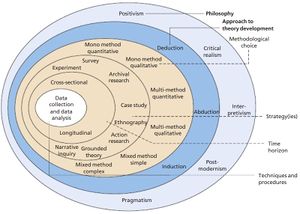 |
Bestand:Reseach onion.jpg | Research oninon | Saunders et al. | 2105 |
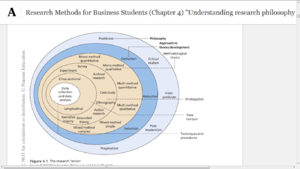 |
Bestand:Reseach onion.png | Research onion | Saunders et al. | 2015 |
| Gettier problem | Resource Hyperlink 00119 | Gettier problem | Wikipedia | 22 september 2016 |
| DIKW pyramid | Resource Hyperlink 00120 | DIKW pyramid | Wikipedia | 22 september 2016 |
| Research onion is je beste vriend | Resource Hyperlink 00121 | Research onion is je beste vriend | De afstudeerconsultant | 22 september 2016 |
| Research Methods for Business Students | Resource Hyperlink 00122 | Research Methods for Business Students | Saunders et al. | 2015 |
| Abductie | Resource Hyperlink 00123 | Abductie | Wikipedia | 30 september 2016 |
| Inductie | Resource Hyperlink 00124 | Inductie | Wikipedia | 30 september 2016 |
| Deductie | Resource Hyperlink 00125 | Deductie | Wikipedia | 30 september 2016 |
| Wicked problem | Resource Hyperlink 00126 | Wicked problem | Wikipedia | |
| System dynamics | Resource Hyperlink 00127 | System dynamics | Wikipedia | 1 oktober 2016 |
| EMM beeldtaal | Resource Hyperlink 00136 | EMM beeldtaal | Hans de Bruin | 2016 |
| Thesaurus Zorg en Welzijn | Resource Hyperlink 00198 | Thesaurus Zorg en Welzijn | Stimulanz | 9 januari 2017 |
| Power Thesaurus | Resource Hyperlink 00199 | Power Thesaurus | Power Thesaurus | 9 januari 2017 |
| Simple Knowledge Organization System | Resource Hyperlink 00200 | Simple Knowledge Organization System | W3C Semantic Web Deployment Working Group (SWDWG) | 18 augustus 2009 |
